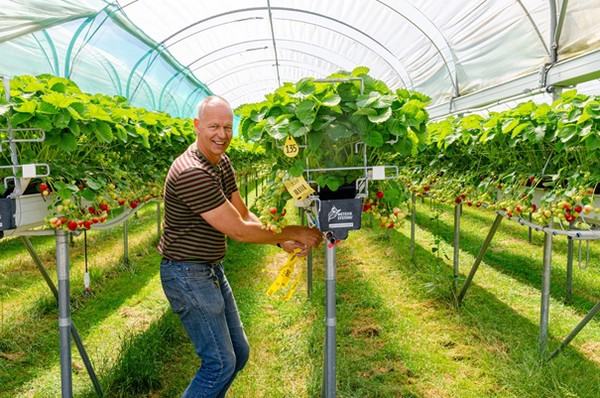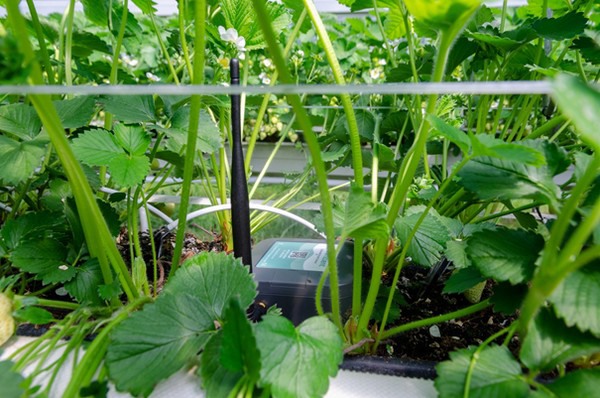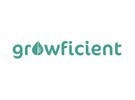In the Netherlands, 60-70% of total strawberry production comes from table-top cultivation. This protected type of cultivation ensures a clean and labor-friendly environment. On table-tops, the cultivation primarily takes place in substrate troughs. The plants are watered using drip irrigation systems, meaning that growers should have more control over their irrigation strategy.
Lacking insights in substrates
Mark van Aert cultivates strawberries on table-tops in Zundert. Although this type of cultivation offers a lot of advantages, Mark indicates that there are still many uncertainties when it comes to irrigation. For example, checking in the morning whether runoff has been realized in time. ''You look at this runoff measurement points only once or twice a day, but never exactly at the right moments'', Mark indicates. ''This means you are missing certain insights in the substrate, especially after warm nights or nights with a lot of wind, meaning that there are mornings when runoff is realized too late''. He adds that because of the fact he sometimes starts at a fixed time, it occurs that he waters too early or too late and too much or too little.

Mark van Aert of Aardbeienkwekerij van Aert
Independent soft fruit consultant Marcel Beekers agrees with this view. ''Insights about the water uptake are lacking, especially at the beginning and the end of the day. When the crop has just been planted, the plant is not yet evaporating optimally, and watering is often based on intuition. This also goes for situations with dark or humid weather'', says Marcel. Watering is often started at a fixed time in the morning. But according to him, it is important to know when the plants start evaporating and what the condition of the substrate is. ‘’During the day you also have the information about the measured runoff and runoff-EC, but these are often snapshots and do not represent the current condition of the substrate'', Marcel acknowledges.
''Also, tipburn and production loss are possible consequences of watering too late, especially with fluctuating weather conditions, high radiation or a lot of wind'', says Mark. Marcel concurs ''to some extent, this could be avoided by making sure the substrate is not too wet or too dry at critical moments''. He adds that tipburn, however, is caused by multiple different factors.
Growficient
Growficient supports growers with insights into their substrate, giving them more control and certainty over what is going on in the substrate. Through substrate sensors that are suitable for a wide range of substrate types, the water content, EC, and temperature in the substrate are continuously monitored. This way, Growficient supports growers with monitoring and optimizing their irrigation strategy and therefore also their cultivation. Growficient is very simple to use and offers a reliable insight using multiple sensors per watering section. The online dashboard makes it possible to monitor the situation at any time, even remotely.

Growficient sensor in strawberry
Grip on substrate status
Mark van Aert started using Growficient last year to learn what is happening in his substrate. "We were already very alert about this, but we did this based on our feeling. We wanted to substantiate that knowledge, to avoid watering too much, but at the right moments''. So, Mark started to see Growficient as an extra tool, allowing him to monitor his irrigation strategy remotely: ''When you have these moments of doubt when you think it might be good to go and look at the plants, the dashboard can be decisive in deciding that things are still okay”. So Mark has always been very alert to the state of his substrate but indicates that Growficient is now his tool to be able to look back afterward, to see if he acted the way he wanted during specific moments. ''You learn how to work with the Growficient data. For example, to decide whether or not to set an extra night dripping. Having the data from last year teaches us many lessons''. Marcel also stresses that on table-tops the influence of wind on evaporation should not be underestimated. A fast dry-out of the substrate measured by the sensors can be a reason to give some extra water during the night. Growficient helps to get a clear view of this dry-out in time, whether you are present on the farm or not.
Marcel agrees with Mark that learning from the data is important. ''You can adjust the irrigation strategy based on the measured data so that the right amount is given at the right time.'' As an example, he mentions that he can clearly see from the graphs when the plant becomes active in the morning and starts to evaporate. That is exactly the time to start watering the plants. These kinds of insights are very important in the spring and the summer. ''The start of the season is a difficult time. The plants do not yet evaporate optimally, and a lot is done based on the feeling of the grower. But you want to avoid giving too little water causing the runoff- EC to rise. The latter of course also applies during the summer''. Growficient offers the possibility to respond accurately throughout the entire season.
As for problems like tipburn: according to Marcel and Mark, this cannot be solved completely by using sensors, because there are many different causes. However, they both believe that it can partly help to prevent the substrate from being too dry or too wet at critical moments.
Connection to watering computer
According to Marcel, it would be nice to eventually be able to connect Growficient to the climate or irrigation computer. This would make it possible to automatically determine the starting moments and nightly watering based on the water absorption and evaporation. The first important step, according to him, is: "Gaining experience with the data and actively dealing with it by reasoning and learning, in order to subsequently start using limit values".
 For more information:
For more information:
Growficient
Dirk Jan Mulder
dirkjan@growficient.com
www.growficient.com

